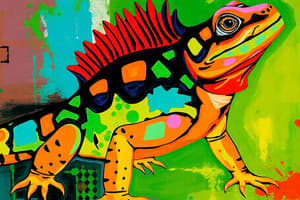Podcast
Questions and Answers
What key adaptation allowed reptiles to reproduce away from water?
What key adaptation allowed reptiles to reproduce away from water?
- Scaly skin
- Lung adaptations for gas exchange
- Development of strong limbs
- Amniotic egg (correct)
Which extinction event significantly reduced the reptilian population about 252 million years ago?
Which extinction event significantly reduced the reptilian population about 252 million years ago?
- End-Triassic Extinction
- Permian-Triassic Extinction (correct)
- Holocene Extinction
- Cretaceous-Paleogene Extinction
Which characteristic is common among all reptiles?
Which characteristic is common among all reptiles?
- Warm-blooded metabolism
- Presence of a mammary gland
- Aquatic habitat preference
- Scaly and impermeable skin (correct)
Which of the following is NOT one of the main orders of reptiles?
Which of the following is NOT one of the main orders of reptiles?
How many species of reptiles exist in today's world?
How many species of reptiles exist in today's world?
Which of the following statements about reptilian adaptations is false?
Which of the following statements about reptilian adaptations is false?
Which clade of reptiles includes both crocodilians and birds?
Which clade of reptiles includes both crocodilians and birds?
What evolutionary development is characteristic of the earliest reptiles known as cotylosaurs?
What evolutionary development is characteristic of the earliest reptiles known as cotylosaurs?
Flashcards are hidden until you start studying
Study Notes
Origin Of Reptiles
- Reptiles evolved from ancestral amphibians approximately 300 million years ago during the Carboniferous period.
- Key evolutionary transition: Development of the amniotic egg, allowing reproduction away from water.
- Early reptiles are known as "cotylosaurs," which gave rise to various reptilian lineages.
Adaptations In Reptiles
- Skin: Scaly, impermeable skin to reduce water loss; keratinized layers for protection.
- Respiration: Lungs adapted for efficient gas exchange, allowing life in diverse environments.
- Temperature regulation: Ectothermic behavior; basking in the sun or seeking shade to regulate body temperature.
- Limbs: Stronger limbs for walking and digging, adaptations for various terrains.
Extinction Events
- Major extinction events have shaped reptilian evolution:
- Permian-Triassic Extinction (about 252 million years ago): Eliminated nearly 90% of species, paving the way for dinosaur dominance.
- Cretaceous-Paleogene Extinction (about 66 million years ago): Led to the extinction of non-avian dinosaurs, allowing mammals to diversify.
- Ongoing threats include habitat destruction, climate change, and pollution affecting current reptile populations.
Diversity Of Reptile Species
- Approximately 10,000 species of reptiles exist today, categorized into four main orders:
- Crocodylia: Crocodiles, alligators; semi-aquatic predators.
- Squamata: Lizards and snakes; largest order with diverse adaptations.
- Testudines: Turtles and tortoises; characterized by a bony shell.
- Rhynchocephalia: Tuatara; a unique lineage from New Zealand, resembling lizards.
- Reptile habitats range from deserts to rainforests, showing vast ecological adaptability.
Evolutionary Lineages
- Reptiles are divided into two primary clades:
- Lepidosauria: Includes squamates (lizards and snakes) and tuataras.
- Archosauria: Includes crocodilians and birds (which are considered modern dinosaurs).
- The evolutionary history shows a split between the lineages that led to modern reptiles and birds, highlighting their common ancestry with dinosaurs.
- Fossil records provide insight into the gradual changes in morphology, behavior, and ecology through geological time.
Origin Of Reptiles
- Reptiles emerged from ancestral amphibians around 300 million years ago during the Carboniferous period.
- The development of the amniotic egg was a crucial evolutionary leap, enabling reproduction in terrestrial environments.
- Early reptiles, known as "cotylosaurs," were the ancestors of numerous reptilian lineages.
Adaptations In Reptiles
- Scaly, impermeable skin helps minimize water loss, while keratinized layers provide physical protection.
- Advanced lung structures facilitate efficient gas exchange, supporting survival in varied habitats.
- Ectothermic behaviors allow reptiles to regulate body temperature by basking or seeking shade.
- Stronger limbs evolved for effective locomotion across diverse terrains, aiding in walking and digging.
Extinction Events
- The Permian-Triassic Extinction (approximately 252 million years ago) caused the loss of nearly 90% of species, leading to the rise of the dinosaurs.
- The Cretaceous-Paleogene Extinction (around 66 million years ago) resulted in the extinction of non-avian dinosaurs, creating opportunities for mammalian diversification.
- Current reptile populations face ongoing threats from habitat destruction, climate change, and pollution.
Diversity Of Reptile Species
- About 10,000 reptile species are recognized today, classified into four primary orders:
- Crocodylia: Includes crocodiles and alligators, adapted as semi-aquatic predators.
- Squamata: Comprises lizards and snakes, the largest order with extensive adaptations.
- Testudines: Encompasses turtles and tortoises, distinguished by a protective bony shell.
- Rhynchocephalia: Contains the tuatara, a unique lineage from New Zealand resembling lizards.
- Reptiles inhabit diverse ecosystems, ranging from deserts to rainforests, demonstrating extensive ecological adaptability.
Evolutionary Lineages
- Reptiles are categorized into two main clades:
- Lepidosauria: Encompasses squamates (lizards and snakes) and tuataras.
- Archosauria: Includes crocodilians and birds, which are regarded as modern dinosaurs.
- The evolutionary history indicates a significant split between the lineages leading to current reptiles and birds, emphasizing their shared ancestry with dinosaurs.
- Fossil records reveal gradual morphological, behavioral, and ecological changes throughout geological history.
Studying That Suits You
Use AI to generate personalized quizzes and flashcards to suit your learning preferences.





